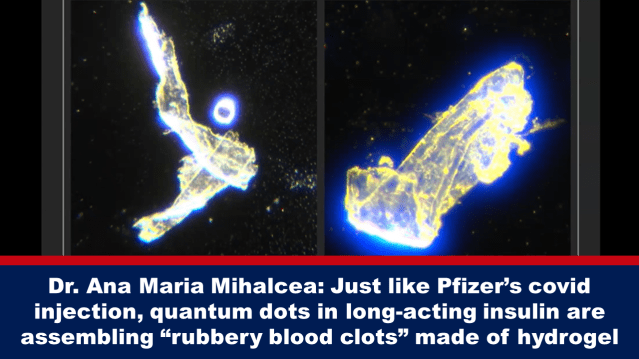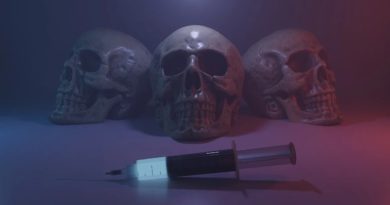Dr. Ana Maria Mihalcea: Just like Pfizer’s covid injection, quantum dots in long-acting insulin are assembling “rubbery blood clots” made of hydrogel
Dr. Ana Maria Mihalcea has been analysing long-acting insulin and what she has found is shocking. One of her patients recently suffered from congestive heart failure and now he is wondering if the insulin he injects himself to treat his diabetes has caused it.
“I recently found out that my insulin has AI self-assembling technology in it. I am basically getting [covid] bioweapon injections against my will. This was apparently discovered in other people’s insulin too. Ana Mihalcea, M.SD., PhD has analysed my Lantus and Humalog insulin. Using darkfield microscopy Dr. Mihalcea documents the AI self-assembly occurring in the insulin in this video,” Joseph Sansone wrote and linked the video below.
Let’s not lose touch…Your Government and Big Tech are actively trying to censor the information reported by The Exposé to serve their own needs. Subscribe now to make sure you receive the latest uncensored news in your inbox…
In the video above, Dr. Mihalcea began by highlighting that Lantus long-acting insulin is made by Sanofi. In 2012, Sanofi opened a plant in China to produce its pre-filled insulin injection pen Lantus SoloSTAR. Sanofi has also been involved in the manufacture of mRNA covid injections, producing 100 million doses for Pfizer-BioNTech.
“It’s long been known that advanced hydrogels are being used for the controlled delivery of insulin,” Dr. Mihalcea said.
Hydrogel is a programmable substance that can self-assemble from nanoscale to centimetres in size within minutes. Quoting from an article published in the journal Pharmaceutics, “hydrogels can mimic the extracellular matrix,” she explained that this means the extracellular space in our bodies can be mimicked by this hydrogel. Continuing with the quote from the article, “and retain large quantities of water with tuneable properties,” Dr. Mihalcea said that “tuneable properties” could also be replaced with “programmable properties.”
The article continues: “Several studies have demonstrated the fixation of insulin within the structural mesh of hydrogels as a bio-scaffold for the controlled delivery of insulin.” The reason why the wording in this article is so important, Dr. Mihalcea explained, is because “the structural mesh is exactly what has been showing up in people’s live blood … these are polymers like polyethylene glycol and other derivatives … so this mesh is clearly visible in the live blood … it’s important to have this background for what I have seen for the Lantus insulin.” For more information about what Dr. Mihalcea has found in blood samples, you can watch her video ‘Evidence of Crimes Against Humanity – Darkfield Blood Microscopy’ HERE.
Lantus ingredients include m-cresol, glycerol and polysorbate 20.
M-cresol is a highly toxic chemical compound. It is traditionally extracted from coal tar, the volatile materials obtained in the production of coke from (bituminous) coal. The chemical datasheet states that m-cresol is considered a poison and a corrosive, and can cause serious or permanent injury:
Health Hazard
INHALATION: Mucosal irritation and systemic poisoning EYES: Intense irritation and pain, swelling of conjunctiva, and corneal damage may occur. SKIN: Intense burning, loss of feeling, wrinkling, white discolouration, and softening. Gangrene may occur. INGESTION: Burning sensation in mouth and oesophagus. Vomiting may result. Acute exposure by all routes may cause muscular weakness, gastroenteric disturbances, severe depression, collapse. Effects are primarily on [central nervous system] CNS and oedema of lungs. Injury of spleen and pancreas may occur.
M-cresol, Chemical Datasheet, Cameo Chemicals
Hydrogel can be used for bio-mimic tissues but it can also be used to create soft robotics and glycerol has been shown to be included in hydrogels for soft sensing applications. Soft sensing means something is measuring our physiological processes and sending that information to the cloud or internet for biomonitoring.
Soft sensing technologies have the potential to revolutionise wearable devices, haptic interfaces and robotic systems.
This work reports the development of a versatile ionic gelatin-glycerol hydrogel for soft sensing applications. The resulting sensing device is inexpensive and easy to manufacture, is self-healable at room temperature, can undergo strains of up to 454%, presents stability over long periods of time, and is biocompatible and biodegradable. [Emphasis our own.]
Self-healing ionic gelatin/glycerol hydrogels for strain sensing applications, NPG Asia Materials, 18 February 2022
Dr. Mihalcea has done extensive research on clots from deceased persons as well as clots forming in living people. These rubbery clots do not dissolve. Dr. Mihalcea has attempted to dissolve them using nine different solvents, including different acids. “We have tried to degrade these things and the most corrosive chemicals cannot do it,” she said.
Polysorbate 20 is 20 units of polyethylene glycol (“PEG”):
As the name implies, the ethoxylation process leaves the molecule with 20 repeat units of polyethylene glycol.
Polysorbate 20, Wikipedia
The lipid nanoparticle for the Pfizer-BioNTech covid injections contains PEG to evade the body’s innate immune system. Not only is this a hazard to people who are allergic to PEG, but it can also cause an inflammatory or allergic response with repeated injections among others. PEG is also used for other reasons:
Polyethylene glycol (PEG) hydrogels are widely used in a variety of biomedical applications, including matrices for controlled release of biomolecules and scaffolds for regenerative medicine. [Emphasis our own.]
Lin, CC., Anseth, K.S. PEG Hydrogels for the Controlled Release of Biomolecules in Regenerative Medicine. Pharm Res 26, 631–643 (2009). https://doi.org/10.1007/s11095-008-9801-2
“So, you can load biomolecules with these PEGylated hydrogels [ ] this is important as you will see how the molecules within the Lantus will self-assemble,” Dr. Mihalcea said.
Beginning at timestamp 14:00 Dr. Mihalcea showed some images of what she found in Lantus insulin. Below we have selected a few to give some indication of what she has found.
Below are some filaments, similar to what has been found in covid injections. The spherical object in the left-hand side image is “classic of hydrogel,” Dr. Mihalcea said.
In the image below, Dr. Mihalcea explained that the yellow spots are hydrogel coagulating and the blue dots are quantum dots.
To add to Dr. Mihalcea’s explanation of quantum dots: Speaking to Mike Adams last year, Karen Kingston explained that a patent showed how the size of the quantum dot responds to different energies or frequencies. A 2011 book titled ‘Quantum Confinement Effect’ describes how quantum dots can be used to create tags, “so to mark people or animals,” Kingston said.
Kingston went on to explain that opal hydrogels are part organic and inorganic. This means that they are part biology and part technology. Part technology – artificial intelligence, metallic structures. Part biology – genetic sequences from other life forms e.g., insects, reptiles, rodents. Opal hydrogels look like quantum dots. “They have this bright blue and rainbow colours they give off,” Kingston explained.
A peer-reviewed article published by Wiley Online Library clearly states that the “backbone, the energy source, the technology between inorganic and organic – the inorganic-organic hybrids – is Qdots, it’s quan[tum] dots,” Kingston said.
Read more: Covid “Tests” and “Vaccines” Are Delivering a Hybrid Biological/Technological Weapon Which is Activated By 5G, Fibre Optics and Light, The Exposé, 26 October 2022
In the image below and a closer view immediately after, Dr. Mihalcea explained that the quantum dots are assembling, building a complex structure and a mesh-like fibre.
At this point, Dr. Mihalcea reminded us of the use of PEG hydrogel for “the controlled release of scaffolds,” structural mesh, bio-structures and hydrogels that would “mimic the extracellular matrix” mentioned earlier. “This is what is happening here. A dense meshwork that is intercepted by these quantum dots that are artificially intelligent and are able to direct the self-assembly,” she said.
Dr. Mihalcea showed several videos of samples as seen through the microscope and talks through what is happening. It would be futile to attempt to describe what the videos show and do it justice – there is simply too much activity, too much information, even in one drop of Lantus.
But in short, Dr. Mihalcea shows how quantum dots – using artificial intelligence and coordinating with each other, using the light they emit for communication – build hydrogel masses by attaching or gluing hydrogel pieces together. This same process of quantum dots building hydrogel masses is what Dr. Mihalcea has seen happen in a Pfizer-BioNTech covid injection sample she was able to observe. Over time, she explained, these masses will “grow” to become the “rubbery blood clots” that are being found in people’s bodies by embalmers.
“This is very powerful evidence that, literally, Lantus insulin is a weapon, not a medication,” she said. “People must understand that the pharmaceutical industry has been weaponised against them.”
Further resources:

This article has been archived for your research. The original version from The Exposé can be found here.



